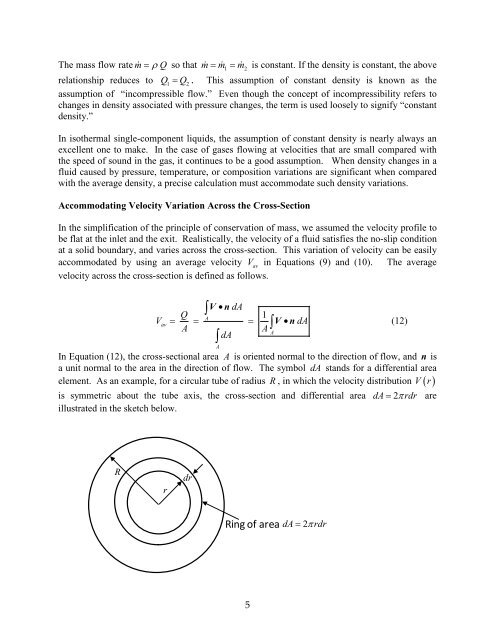Conservation of Mass - Clarkson University
Conservation of Mass - Clarkson University
Conservation of Mass - Clarkson University
Create successful ePaper yourself
Turn your PDF publications into a flip-book with our unique Google optimized e-Paper software.
The mass flow rate m = ρ Q so that m = m1 = m 2is constant. If the density is constant, the aboverelationship reduces to Q1 = Q2. This assumption <strong>of</strong> constant density is known as theassumption <strong>of</strong> “incompressible flow.” Even though the concept <strong>of</strong> incompressibility refers tochanges in density associated with pressure changes, the term is used loosely to signify “constantdensity.”In isothermal single-component liquids, the assumption <strong>of</strong> constant density is nearly always anexcellent one to make. In the case <strong>of</strong> gases flowing at velocities that are small compared withthe speed <strong>of</strong> sound in the gas, it continues to be a good assumption. When density changes in afluid caused by pressure, temperature, or composition variations are significant when comparedwith the average density, a precise calculation must accommodate such density variations.Accommodating Velocity Variation Across the Cross-SectionIn the simplification <strong>of</strong> the principle <strong>of</strong> conservation <strong>of</strong> mass, we assumed the velocity pr<strong>of</strong>ile tobe flat at the inlet and the exit. Realistically, the velocity <strong>of</strong> a fluid satisfies the no-slip conditionat a solid boundary, and varies across the cross-section. This variation <strong>of</strong> velocity can be easilyaccommodated by using an average velocity Vavin Equations (9) and (10). The averagevelocity across the cross-section is defined as follows.Vav∫V • ndAQA1= = = • dAAA∫V n (12)AdA∫AIn Equation (12), the cross-sectional area A is oriented normal to the direction <strong>of</strong> flow, and n isa unit normal to the area in the direction <strong>of</strong> flow. The symbol dA stands for a differential areaV relement. As an example, for a circular tube <strong>of</strong> radius R , in which the velocity distribution ( )is symmetric about the tube axis, the cross-section and differential area dA = 2πrdr areillustrated in the sketch below.RrdrRing <strong>of</strong> area dA = 2πrdr5
















